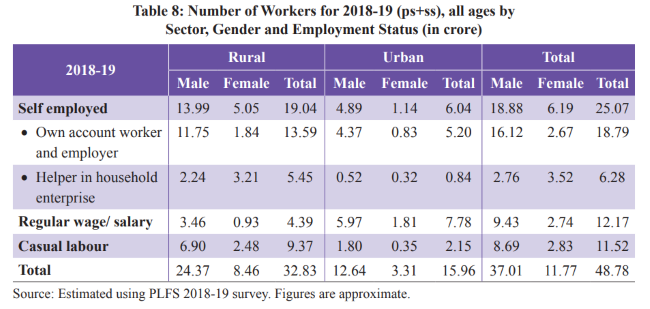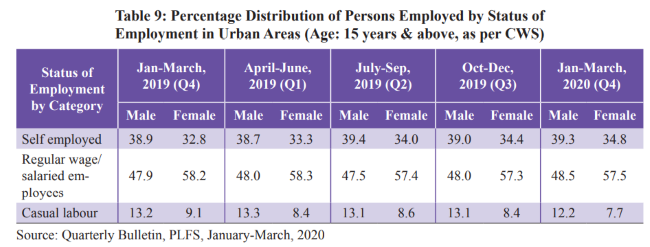
The ministry of labour and employment has finalised the rules for the implementation of the four new labour codes, paving the way for their rollout. The Narendra Modi government introduced the labour codes to simplify the numerous overlapping labour laws, passed by Parliament and state assemblies.
Indian Parliament passed the Industrial Relations Code, the Code on Social Security, and the Occupational Safety, Health and Working Conditions Code, in the monsoon session of 2020. It had passed the Code on Wages in the 2019 monsoon session. These four codes have subsumed 29 labour laws already in existence.
Several of the 29 national-level labour laws were up to 70-80 years old and were made in the industrial era. The Indian economy has since transformed itself into a predominantly service economy with services contributing more than half of the gross domestic product (GDP) of the country. An effort has been made in consolidating labour laws relating to employment conditions, social security, and wages.
READ I Budget 2021: Monetisation of land key to fiscal consolidation, not spending cuts

Labour codes: Code on Wages, 2019
The Code of Wages amalgamates four laws on wages and bonus — Payment of Wages Act, 1936, Minimum Wages Act, 1948, Payment of Bonus Act, 1965 and Equal Remuneration Act, 1976. The different definitions of wages under these laws will give way to a single definition, making compliance easier and reducing the scope of litigation.
The Code brings in the concept of floor wage, which will be fixed by the Union government after factoring in the living standards of workers in different states. The minimum wages fixed by the state governments cannot be less than the floor wage. The floor wage is applicable to all establishments irrespective of their size and number of employees. It applies to all workers in the unorganised sector too. The introduction of floor wage is aimed at providing a minimum standard of living for all workers in the country.
An employer can deduct an employee’s wages on specific grounds such as fines, absence from duty, accommodation given, and recovery of advances. The deductions cannot exceed 50% of the total wages. The union and state governments can fix the number of hours in a normal working day. Overtime rates cannot be less than twice the normal wages. The government can determine the wage limit for determining the eligibility and calculation of bonus. The bonus provision is applicable to those establishments that employ twenty or more persons on any day during the year.
READ I Consultations, regulation key to the success of banking reforms unveiled in Budget 2021

Industrial Relations Code
The Industrial Relations Code will replace the Trade Union Act 1962, Industrial Employment (Standing Orders) Act 1946 and The Industrial Disputes Act 1947. The code drew flak for the stipulation that companies that employ up to 300 workers are not required to take government approval for firing workers and closing the plant. Establishments with more than 300 employees will need prior government approval for such action.
Another controversial provision of the code is that it introduces conditions on the workers’ rights to go on strike. The term strike is redefined to include casual leave taken by more than half of the employees. Trade unions need to give 14-days notice before going on strike. According to another provision of the code, workers cannot go on strike for 60 days after the completion of proceedings before an Industrial tribunal or a labour tribunal.
The code redefines “worker” to include people in supervisory capacity drawing salaries of up Rs 18,000 per month. It introduces the concept of negotiating trade union and negotiating trade councils to streamline negotiations.
READ I Indian economy: Focus on fiscal consolidation will hurt fragile recovery
Occupational Safety, Health and Working Conditions Code
The Occupational Safety, Health and Working Conditions Code has subsumed 13 Acts including the Factories Act 1948, Contract Labour (Regulation and Abolition) Act 1970, Inter-State Migrant Workmen (Regulation of Employment and Conditions of Service) Act 1979, Building and Other Construction Workers (Regulation of Employment and Conditions of Service) Act 1996, Mines Act, 1952, Dock Workers (Safety, Health and Welfare) Act 1986, Plantations Labour Act, 1951, and Working Journalists (Fixation of Rates of Wages) Act 1958.
The Code widens the scope of the law by bringing inter-state migrants, sales promotion employees and audio-visual workers into its ambit. It also seeks to promote gender equality by easing norms to employ women workers in night shifts.
The code makes it mandatory for employers to issue a letter of appointment. The employer is also required to conduct free annual health examinations for workers above 45 years of age. The draft rules for the implementation of the code have stipulated a maximum of 12 working hours in a day inclusive of intervals and 48 hours per week. The code stipulates that workers of an establishment cannot be required to work for more than 6 days in a week. Those workers who have worked 180 days or more in a calendar year can avail one day leave for every 20 working days.
READ I Technology and business growth: Seven guidelines for small and medium enterprises
Code on Social Security
The Code on Social Security subsumes nine legislations including the Employees Compensation Act 1923, Employees Provident Fund and Miscellaneous Provisions Act 1952, Employees State Insurance Act 1948, Maternity Benefit Act 1961, Unorganized Workers’ Social Security Act 2008, Payment of Gratuity Act 1972, Employees Exchange Act 1959, Building and Other Construction Workers Cess Act 1996 and Cine Workers Welfare Fund Act 1981.
It extends benefits such as maternity leave, disability insurance, gratuity, health insurance and old age protection to the workers in the unorganized sector. This will benefit gig workers, platform workers, contract workers, freelancers and home-based workers.
The Code proposes gratuity benefits to fixed-term contract employees by lifting the requirement of minimum service. The social security fund plan mandates platforms and aggregators to make contributions equivalent to 1-2% of the turnover or 5% of the worker’s wages. The Union and state governments are also free to contribute to the social security fund.
READ I Truth serum: Govt must speed up Covid-19 vaccination drive
What labour codes mean to employers, employees
Several experts and trade unions have termed these labour codes as anti-worker and employer-friendly. The most important objection from them is that the codes stipulate size-based applicability of laws to industrial establishments, leaving out lakhs of industrial units from the ambit of law. Another provision in the cross-hairs of trade unions is the strict notice period obligation for declaring strikes. Some other criticisms include:
- Employees in small units (India has more than 6 million of them) will lose protection of labour laws, unions.
- The codes compromise the safety of workers by allowing employers to introduce arbitrary service conditions.
- The labour codes encourage a system of hiring and firing workers without prior government permission.
- Curbs on workers’ strikes and demonstrations restrict freedom of industrial action.
- The codes compromise women’s safety by allowing establishments to deploy women in night shifts, which may result in sexual abuse.
The effort was to consolidate labour laws, rather than reforming them. The codes have expanded the ambit and applicability of some laws, removed multiple definitions/ authorities, removed some obsolete provisions, rationalised penalties, and made compliance easier for the industry.
Anil Nair is Founder and Editor, Policy Circle.

